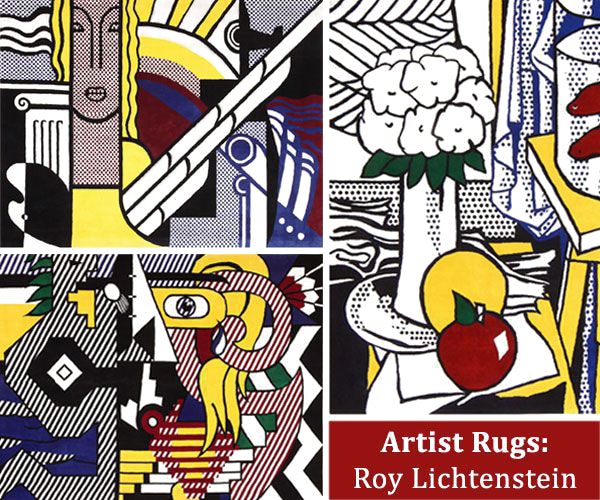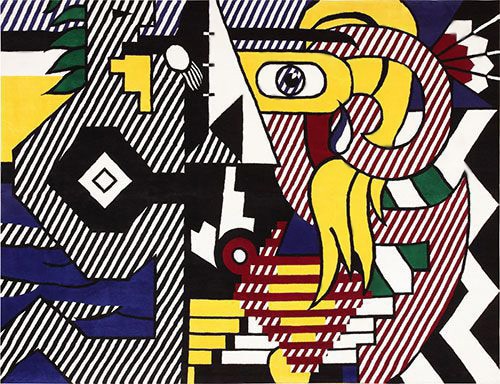Roy Lichtenstein Rugs
View our current collection of Pop Art rugs by Roy Lichtenstein
Learn More About Pop Art Rugs by Artist Roy Lichtenstein
View our entire collection of art rugs and carpets by famous artists
Roy Lichtenstein Rugs – One of the first pop art artists to find a national audience, Roy Lichtenstein (1923-1997) was acclaimed for creating art that was as controversial as it was bold. His large-scale masterpieces were an imposition of color and shape, influenced by a variety of artistic styles, from Impressionism to Cubism, Surrealism and Expressionism. Reflecting on the themes that became synonymous with his work, he noted ironically: “All abstract artists try to tell you that what they do comes from nature and I’m always trying to tell you that what I do is completely abstract.”
Born and raised on the Upper West Side of Manhattan, Lichtenstein’s family was financially comfortable and stable. As a child, he sampled the delights of the city, which included jazz concerts at the Apollo Theater in Harlem, as well tours of its prestigious museums. As a teenager, he became interested in watercolor and immersed himself in his craft at Parson’s School of Design. Later, Lichtenstein studied fine arts at Ohio State University, where he earned both a bachelor’s and master’s degree.
Lichtenstein’s early career was spent exploring traditional artistic subjects, including folklore and mythology. By the 1960’s he began to carve out his own artistic voice, deconstructing iconic images that were popular in cartoon strips. Roy Lichtenstein’s first solo art exhibition in 1962 elevated him to national prominence, a position he held throughout his distinguished career.
Lichtenstein’s work was an ironic commentary on ‘low art’ forms that were culturally ubiquitous. Some of his most famous pieces represent cartoon images that utilize a Ben-Day dots technique, a printing method common in pulp comic books. Often, he would reconstruct a comic image in dots, emphasizing primary colors (red, yellow and blue). Then he would line the forms with heavy strokes of black. Later in his career, he began to focus on sculpture, painting on everyday objects such as lamps and coffee cups. Lichtenstein also provided designs that would result in some truly exceptional area rugs. He also played with space, using mirrors to create a sense of form outside the artistic frame. In one of his last series, he created home interiors that were inspired by yellow page ads from a telephone book.
Lichtenstein spent most of his working career in New York, dividing his time between a house he owned on Long Island and an apartment in Manhattan. Before his death, he donated 154 of his paintings to the National Gallery of Art, however, art historians estimate that there are thousands of his paintings and sculptures worldwide. Unfortunately, one of these paintings, The Entablature Series, was destroyed on September 11th, 2001, as a result of the attacks on the World Trade Center.
Roy Lichtenstein’s contributions to contemporary art continue to reverberate in the art world. Although his subject matter often mined the trivial, his engagement with the artifacts of social custom expanded our definition of art, making him one of the most relevant and important figures of the 20th Century.
Roy Lichtenstein Pop Art Rugs
Roy Lichtenstein Rugs at the Nazmiyal Collection — Overthe years, the Nazmiyal Antique Rugs has acquired an impressive selection of rugs by renowned fine artists. In this post, we take a look at the man behind three of these rugs: pop artist Roy Lichtenstein.
More than just pop art rugs, these pieces are truly works of art. For more, check out our Roy Lichtenstein rugs inspired Pinterest Boards!

Roy Lichtenstein Rugs Pop Art Style
Roy Lichtenstein (1923 – 1997) was an American artist who is known for his contributions to the mid-century Pop Art style. He drew much aesthetic inspiration for his works from 1960’s popular media, and his paintings contain several recurring homages to comic-strip style, such as his use of Ben-Day dots, strong outlines, and text bubbles. His works vary greatly in theme, from still lives, to portraits, to abstract pieces, but his oeuvre is united by his strict use of color and line. Lichtenstein’s distinct style makes his work instantly recognizable and iconic.
Lichtenstein was born in New York City to an upper-middle-class Jewish family. During his teenage years, he became a passionate fan of jazz, and one of his first artistic pursuits was drawing the portraits of musicians that he saw play at the popular Apollo Theater in Harlem. After finishing high school, Lichtenstein enrolled in the University of Ohio’s studio art program, and began working toward a career as an artist. Eventually, he attained his Masters of Fine Arts degree from the school, and accepted a teaching position as a studio art instructor there, which he held for over ten years.

Pop Art Rugs by Roy Lichtenstein
In 1951, Lichtenstein held his first solo exhibition at the Carlebach Gallery in New York. Although he was living in Cleveland at the time, the artist took frequent trips to New York, taking odd jobs as a draftsman or window decorator. In 1957, the artist moved back to New York, and accepted a position as a painting instructor at the State University of New York in Oswego.
It was during this time that Lichtenstein began to embrace the popular Abstract Expressionism style into his works. The roots of his “pop sensibility” appear in this early work, with cartoon characters like Mickey Mouse and Bugs Bunny making cameos in his otherwise abstract pieces.

Pop Art Roy Lichtenstein Rugs
During the early 1960’s, Lichtenstein began to rework his style into the pop aesthetic that he is associated with today. He was incredibly interested in capitalist culture, and was fascinated by the idea of the homemaker-as-consumer. References to advertising and commercial sign-making began to appear in his work, and he became more interested in bold linework and simple colors.
It was also during the early 1960’s that Lichtenstein began painting more recognizable characters, such as DC comic-strip damsels and gum-wrapper mascots. At first, critics were skeptical of the originality of these works, and dismissed them as void of meaning.
However, as the pop movement gained traction, Lichtenstein would be embraced as one of its greatest ambassadors for his investigations of mass-media imagery. In later years, prominent cartoonist Bill Griffith stated of Lichtenstein, “There’s high art and there’s low art. And then there’s high art that can take low art, bring it into a high art context, appropriate it and elevate it into something else”.

Roy Lichtenstein Pop Art Rugs
By the end of the 1960’s, Lichtenstein had turned away from his depictions of comic strips, and began to focus his artistic critique on Modernism. During this period, he recreated famous works by impressionists like Cezanne, Mondrian, Picasso, and Van Gogh in his own established pop-style. These works express both Lichtenstein’s reverence for the previous century’s contribution to the Western Canon, and also a suggestion to the art world to perhaps not take itself so seriously.
In addition to his own paintings and sculptures, Lichtenstein licensed and commissioned consumer goods to be made from his work, including everything from graphic textiles to pop-painted Nascar vehicles. Nazmiyal Collection is proud to be in possession of some of these art-objects, in the form of three signed Lichtenstein pop art rugs.
The rugs come to the Nazmiyal Collection from the Seligmann Estate in France. The Seligmann family has been involved in the European and American art markets since the turn of the 20th Century, and their galleries are credited with popularizing modern art in Europe. These rugs are from the Seligmann’s 1970’s reserves, during which time the company absorbed the popular Lucie Weill Gallery and its collection.
The Lucie Weill Gallery (now named the Lucie Weill-Seligmann Gallery) was known to have produced a number of artist rugs during the mid 20th Century. In addition to the three Lichtenstein rugs acquired by the Nazmiyal Collection, the Lucie Weill Gallery produced rugs after Pablo Picasso, Fernand Léger, and André Derain. The Lucie Weill Gallery supplied artists’ rugs to the well-known Charles Slatkin Gallery in New York, in addition to the Seligmann Galleries in France.
Each of the three Lichtenstein rugs are distinctly recognizable — from their color palettes of primary red, blue, and yellow, to their bold use of outline and shape, these rugs are each iconic works of art. These three rugs are perfect for adding a bold touch of mid-century pop to any interior.
